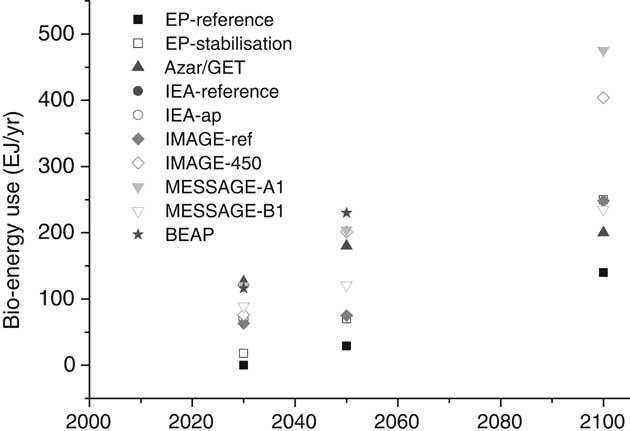
Figure 4-29. Biomass use in the different global energy scenarios, (range of different studies). Source: Dornburg et al., 2008.
should not be underestimated. Obviously, transporting bio-energy across the world would become a major new challenge as well.
While there is controversy on the size of the effect, major bioenergy use certainly affects environmental resources (e.g., water, land and biodiversity). Therefore, it is very important to understand and quantify the impacts and performance of bioenergy systems for determining how successful the use of biomass for energy (and materials) is, how the benefits of biomass use can be optimized and how negative impacts can be avoided.
4.4.5.5 Most important implications forAKST
Large scale use of bioenergy could transform the agricultural system into a net producer of energy. As indicated in latter parts of this assessment, the potential of bioenergy is such that it requires data and information tools for decision making based on solid technical, social and economic knowledge. The intrinsic interdisciplinary character of bioenergy means that implications for AKST will encompass areas as varied as agricultural and energy policies, natural resources and biodiversity protection and rural development. Interaction between the agricultural sector and the energy, environment and industrial sectors as well as sustainability protocols will be vital for successful bioenergy use. From the overall bioenergy chain point of view, it is important to monitor and further improve systems with respect to (1) implications for soil and water; (2) supply of agricultural inputs (fertilizer, fuel, machinery); (3) increasing overall efficiency and (4) minimizing effects on biodiversity.
4.4.6 Labor
4.4.6.1 Trends in employment of labor in agriculture
Hardly any information on labor projections is found in the currently published scenario studies. Therefore, historical trends are used here to assess future trends. Over the last 10 years, there has been a global decline in the relative share of employment in agriculture: from 46% in 1994 to 43% in 2004. However, agriculture continued to be the largest
source of employment (around 60%) in sub-Saharan Africa, South Asia and East Asia. At the same time, the share of agriculture in total employment in developed countries is small: only 4% in 2004 and likely to decline further. As the trends observed above (both in time—and across regions) are global, they are projected to continue, leading to ever lower numbers employed in agriculture. This decline underlies many of the economic projections of future scenarios. The share of agriculture in total employment will decrease dramatically in developing countries and decline more slowly in industrialized countries.
4.4.6.2 Labor productivity in agriculture
Future trends in labor productivity are expected to increase, based on the evidence over the past decade. Labor productivity in the world increased by almost 11 % over the past ten years (ILO, 2005). This increase was primarily driven by the impressive growth in labor productivity in Asia and the industrialized economies. The transition economies have also contributed to the world's recent growth in productivity. The Latin America and the Caribbean realized productivity increase of just over 1% over 10 years, mainly due to the economic crisis in the beginning of the century. There were no changes in the Middle East and North Africa, while sub-Saharan Africa experienced declining productivity on average. Similar trends in future productivity are anticipated. Based on historical data for 71 countries from 1980 to 2001, agricultural GDP per worker in sub-Saharan Africa on average grew at a rate of 1.6% per year slower than for countries in Asia, Latin America, the transition economies and the Mediterranean countries (Gardner, 2005). Agricultural GDP per laborer and national GDP were positively correlated based on data for 85 countries for 1960-2001. Within each of the regional grouping (Africa, Asia, and Latin America), the countries that grew fastest in national GDP per capita also grew fastest in agricultural GDP per worker, with a few notable exceptions, e.g., Brazil (Gardner, 2005; ILO, 2005). Levels of productivity in Latin America are the highest in the developing world, followed by the Middle East and North Africa and the transition economies. East Asia, South Asia and sub-Saharan Africa, where the majority of the poor live, have considerably lower average labor productivity (World Bank, 2004a).
An increase in agricultural labor productivity has a more significant direct effect on poverty reduction than increases in total factor productivity (ILO, 2005) and there are indirect effects on poverty from changes in food production and food prices (Dev, 1988; ILO, 2005). Productivity gains can lead to job losses, but productivity gains also lead to employment creation, since technology also creates new products and new processes; hence, the increasing trends in productivity could lead to expanded employment in other sectors such as information and communications technologies (ILO, 2005).There will be a critical need to provide adjustment strategies (financial assistance and retraining) for displaced workers and to ensure growth in the long-term. While in the short run, increased productivity might affect growth of employment in agriculture adversely, this outcome may not hold in the long run. Economic history shows